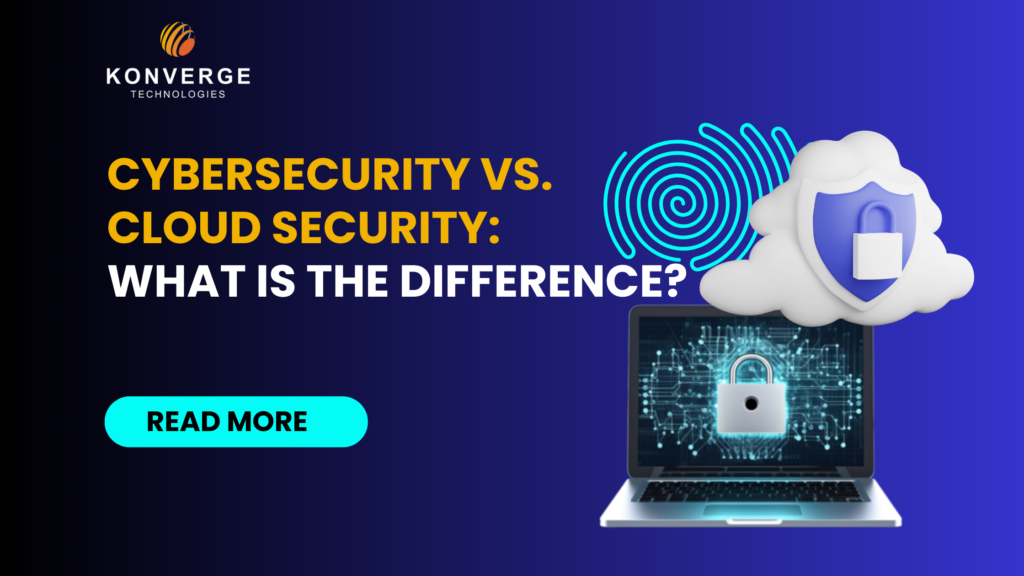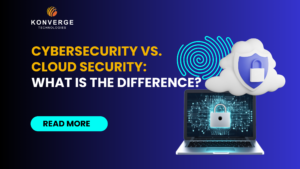
Cybersecurity vs. Cloud Security: What is the Difference?

Introduction:
In today’s digital landscape, distinguishing between cybersecurity and cloud security is paramount for the fortified protection of a company’s IT infrastructure. Cybersecurity, a broad practice, is dedicated to protecting all digital assets from cyber-attacks, including devices, networks, and personal information, ensuring a robust defence against unauthorized access and cyber threats. On the other hand, cloud security, a crucial subset of cybersecurity, zeroes in on the safety of data stored within cloud computing services such as AWS Cloud and Microsoft Azure, concentrating specifically on data security, data protection, and compliance with regulations in the cloud environment.
As we delve deeper into the nuances of cloud computing vs cyber security, it becomes evident that cloud security is not merely an optional addition but a vital component of a comprehensive cybersecurity strategy. This includes specialized roles like cloud security engineers and cybersecurity professionals tasked with safeguarding cloud infrastructure and implementing cybersecurity measures to fend off cyber attacks. Our exploration will highlight the key differences in protecting digital realms, examining the critical roles of security operations centres, network security in cloud computing, and cloud solutions, thereby guiding businesses in making informed decisions on the right security practices for their operations.
Understanding Cybersecurity
Cybersecurity, a term that has become synonymous with digital safety, encompasses a wide array of practices aimed at protecting internet-connected systems, including networks, devices, and data from cyber threats. Unlike cloud security, which focuses specifically on safeguarding cloud-based environments, cybersecurity’s realm is vast, covering:
- Protection Across Various IT Domains: Whether it’s personal computers, servers, or expansive networks, cybersecurity strategies are designed to shield all types of IT areas from malicious attacks.
- Comprehensive Security Measures: Users are often required to implement security protocols themselves, employing antivirus tools and other software to detect and neutralize potential threats.
- Responsibility and Liability: The onus of cybersecurity falls squarely on the device owners, compelling them to adopt measures that ensure the confidentiality, integrity, and availability of information.
Given the broad scope of cybersecurity, it’s crucial to understand its foundational elements, including network security, application security, and disaster recovery, among others. This comprehensive approach not only protects systems and networks from digital attacks aimed at extracting sensitive information but also plays a pivotal role in maintaining business continuity, ensuring regulatory compliance, and safeguarding the company’s reputation. As the digital landscape evolves, the challenge of implementing effective cybersecurity measures grows, underscored by the rising sophistication of cyberattacks and the increasing number of devices at risk.
Exploring Cloud Security
As we pivot towards understanding cloud security, it’s crucial to acknowledge that this domain is intricately designed to combat both external and internal threats within cloud environments. Our journey into the cloud security landscape reveals that:
- Cloud Environments & Their Security Needs:
- Infrastructure-as-a-Service (IaaS): Organizations are tasked with securing user access, operating systems, applications, and network traffic, while the cloud service provider fortifies servers, storage, and networking hardware.
- Platform-as-a-Service (PaaS): Security responsibility is primarily on the cloud service provider for the cloud model and related components, with organizations securing their applications.
- Software-as-a-Service (SaaS): Security terms need negotiation between the organization and the cloud service provider, focusing on the applications provided.
In light of the evolving digital transformation strategies, organizations increasingly incorporate cloud-based tools and services, making cloud security indispensable for maintaining business continuity. This necessity is underscored by the unique challenges cloud security faces, such as lack of visibility, multitenancy issues, complex access management, stringent compliance requirements, and the ever-present risk of misconfigurations.
Addressing these challenges, cloud security employs a multifaceted approach involving Identity and Access Management (IAM), Data Loss Prevention (DLP), Security Information and Event Management (SIEM), and robust business continuity and disaster recovery strategies. Furthermore, Cloud Security Posture Management (CSPM) solutions play a pivotal role in rectifying misconfigurations, ensuring a secure cloud environment. This strategic framework, recommended by NIST, encompasses five pillars: Identify, Protect, Detect, Respond, and Recover, providing a comprehensive blueprint for securing cloud infrastructures against potential threats.
Key Differences Between Cybersecurity and Cloud Security
Diving into the nuances between cybersecurity and cloud security, we observe distinct differences that cater to their specific environments. Let’s dissect these variations to understand their unique roles in protecting digital assets.
- Scope and Focus:
- Cybersecurity: Encompasses the protection of entire information systems, including networks, devices, and data against cyber threats, irrespective of their location.
- Cloud Security: Concentrates on safeguarding data and resources specifically within cloud environments, such as AWS Cloud and Microsoft Azure.
- Responsibility and Compliance:
- Cybersecurity: Places the onus of protecting information and ensuring device security primarily on the owners of enterprise devices.
- Cloud Security: Responsibility is shared; Cloud Service Providers (CSPs) secure the infrastructure, while enterprises manage security within their cloud deployments. Additionally, cloud security tackles unique compliance challenges associated with cloud environments.
- Threat Detection and Data Management:
- Cybersecurity: Utilizes antivirus software requiring frequent updates, and involves manual data backups prone to human error.
- Cloud Security: Employs Artificial Intelligence (AI) for real-time threat detection and offers automated, vendor-managed backups, minimizing data loss risks.
Understanding these key differences enables businesses to tailor their security strategies, ensuring robust protection across both traditional and cloud-based infrastructures.
The Critical Role of AI in Cloud Security
In the realm of cloud security, the integration of Artificial Intelligence (AI) and Machine Learning (ML) has revolutionized how we approach the detection, prevention, and mitigation of cyber threats. These technologies offer a proactive stance in securing cloud environments by enhancing various aspects of security operations:
- Enhanced Threat Detection and Prevention:
- AI and ML algorithms excel at analyzing vast datasets in real time, spotting patterns and anomalies indicative of cyber threats.
- Predictive capabilities allow for the anticipation of potential threats based on behavioural patterns, enabling preemptive action.
- Smart Access Control and Data Protection:
- By understanding typical user behaviours, AI can trigger alerts for any deviations, aiding in the prevention of unauthorized access.
- Unusual data transfer patterns, which might suggest a breach, are quickly identified, safeguarding sensitive information.
- Continuous Learning and Adaptation:
- AI models are in a constant state of evolution, learning from each incident to bolster the security framework.
- The incorporation of advanced techniques like Weight tying and GeGLU Activations, akin to those in GPT-2, enhances the robustness of cloud security measures.
The synergy of AI-driven automation and human expertise forms a formidable defence against cyber threats in cloud environments, ensuring operational efficiency and resilience against emerging challenges. This holistic approach, encompassing encryption, multi-factor authentication, and regular audits, underscores the critical role of AI in modern cloud security strategies.
Choosing the Right Security for Your Business
When deciding between cybersecurity and cloud security for your business, it’s essential to align your choice with your organization’s specific needs, interests, and long-term objectives. Here’s a structured approach to making an informed decision:
- Assess Your Business Needs and Goals:
- Consider whether your operations are heavily reliant on cloud-based services or if they span across various IT environments.
- Determine the level of security required based on the sensitivity of the data you manage and the regulatory compliance your sector demands.
- Implement Best Practices for Robust Security:
- For Cloud Security:
- Utilize access management protocols and multi-factor authentication.
- Monitor cloud activity closely and conduct automated configuration backups.
- Invest in comprehensive cloud security solutions with a focus on AI and machine learning advancements.
- For Cybersecurity:
- Integrate a multi-layered defence strategy covering all IT domains.
- Develop a comprehensive training program focusing on proactive security practices.
- Stay informed on emerging security frameworks like Zero Trust and invest in improved data encryption and tokenization.
- For Cloud Security:
- Cost vs. Effectiveness:
- Acknowledge that while cloud security is generally more effective, especially with its AI-driven threat detection capabilities, it may present a higher cost compared to traditional cybersecurity methods.
- The ultimate choice should consider not only the initial investment but also the potential cost savings from averting data breaches and ensuring business continuity.
By carefully evaluating these aspects, businesses can navigate the complex landscape of digital security, ensuring they choose the right security measures that offer the best protection and value.
Through the comprehensive exploration of cybersecurity and cloud security, we’ve delineated their fundamental differences, underlining their unique roles in the safeguarding of digital assets in varying environments. Cybersecurity spans a wide spectrum protecting everything digital from nefarious cyber threats, while cloud security focuses on the fortification of data within cloud environments, demonstrating a specialized subset that demands distinct strategies and tools for cybersecurity. This comparative analysis not only clarifies the broad and nuanced scopes of both security domains but also emphasizes their pivotal importance in the contemporary digital landscape, highlighting the criticality of adopting tailored security measures that align with specific organizational needs and the evolving nature of cyber threats.
As businesses continue to navigate through the intricate web of digital threats, it becomes evident that choosing the right blend of cybersecurity and cloud security measures is not merely an option but a necessity for ensuring robust protection and business continuity. The strategic integration of AI and ML in cloud security underscores a forward-moving trajectory toward more resilient and adaptive security mechanisms, capable of thwarting sophisticated cyber threats in real time. Ultimately, the decision-making process regarding which security approach to adopt must be informed by an in-depth understanding of the organization’s unique requirements, potential vulnerabilities, and the overarching goal of maintaining not just security, but also regulatory compliance and operational integrity in an increasingly interconnected world.



